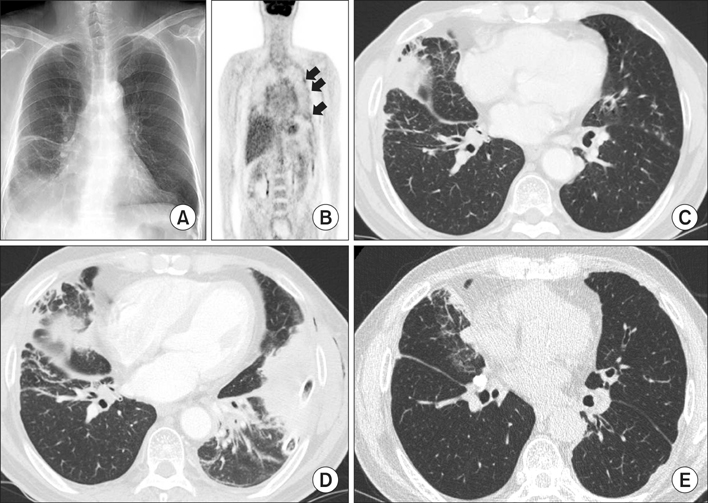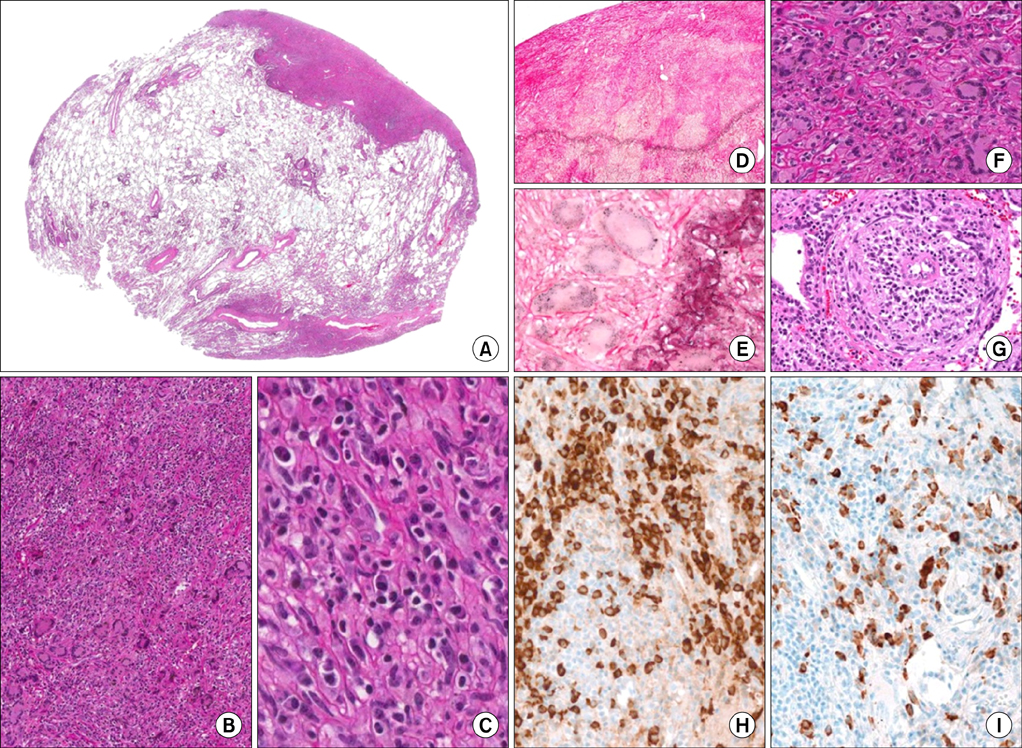Tuberc Respir Dis.
2014 Jan;76(1):42-45.
A Case Report of IgG4-Related Disease Clinically Mimicking Pleural Mesothelioma
- Affiliations
-
- 1Department of Pathology, Sungkyunkwan University School of Medicine, Seoul, Korea. hanjho@skku.edu
- 2Department of Radiology, Sungkyunkwan University School of Medicine, Seoul, Korea.
- 3Department of Internal Medicine, Sungkyunkwan University School of Medicine, Seoul, Korea.
Abstract
- An immunoglobulin G4 (IgG4)-related disease is a recently emerging entity, and a few cases of IgG4-related disease in lung and pleura have been reported. Herein, we report the case of a 74-year-old man with IgG4-related disease of lung and pleura, clinically suspicious of malignant mesothelioma. Chest computed tomography showed diffuse nodular pleural thickening, and microscopic finding disclosed diffuse thickening of visceral pleura with infiltrations of many lymphoplasma cells with increased number of IgG4-positive plasma cells and a few multinucleated giant cells. It is important for pathologists and clinicians to recognize this rare entity and its histologic finding, because it can be confused with malignant tumors on the radiologic examination although it can be treated with steroid therapy.
MeSH Terms
Figure
Reference
-
1. Zen Y, Inoue D, Kitao A, Onodera M, Abo H, Miyayama S, et al. IgG4-related lung and pleural disease: a clinicopathologic study of 21 cases. Am J Surg Pathol. 2009; 33:1886–1893.2. Divatia M, Kim SA, Ro JY. IgG4-related sclerosing disease, an emerging entity: a review of a multi-system disease. Yonsei Med J. 2012; 53:15–34.3. Cheuk W, Chan JK. IgG4-related sclerosing disease: a critical appraisal of an evolving clinicopathologic entity. Adv Anat Pathol. 2010; 17:303–332.4. Shigemitsu H, Koss MN. IgG4-related interstitial lung disease: a new and evolving concept. Curr Opin Pulm Med. 2009; 15:513–516.5. Yamashita K, Haga H, Kobashi Y, Miyagawa-Hayashino A, Yoshizawa A, Manabe T. Lung involvement in IgG4-related lymphoplasmacytic vasculitis and interstitial fibrosis: report of 3 cases and review of the literature. Am J Surg Pathol. 2008; 32:1620–1626.6. Park HY, Han J, Kang G, Yi CA, Chung MP. IgG4-related lung disease presenting as a consolidative mass: a case report. J Lung Cancer. 2010; 9:103–105.7. Yoo JW, Roh JH, Lim CM, Lee SD, Kim WS, Kim DS, et al. Two cases of pulmonary involvement of immunoglobulin G4 related autoimmune disease. Tuberc Respir Dis. 2009; 67:359–363.8. Koss M, Travis W, Moran C, Hochholzer L. Pseudomesotheliomatous adenocarcinoma: a reappraisal. Semin Diagn Pathol. 1992; 9:117–123.9. Kim EY, Kim TS, Han J, Choi JY, Kwon OJ, Kim J. Thoracic epithelioid hemangioendothelioma: imaging and pathologic features. Acta Radiol. 2011; 52:161–166.10. Zen Y, Fujii T, Sato Y, Masuda S, Nakanuma Y. Pathological classification of hepatic inflammatory pseudotumor with respect to IgG4-related disease. Mod Pathol. 2007; 20:884–894.11. Yamamoto H, Yamaguchi H, Aishima S, Oda Y, Kohashi K, Oshiro Y, et al. Inflammatory myofibroblastic tumor versus IgG4-related sclerosing disease and inflammatory pseudotumor: a comparative clinicopathologic study. Am J Surg Pathol. 2009; 33:1330–1340.
- Full Text Links
- Actions
-
Cited
- CITED
-
- Close
- Share
- Similar articles
-
- Clinical Review on Two Cases of Pleural Mesothelioma
- Immunoglobulin G4-Related Lung Disease Mimicking Lung Cancer: Two Case Reports
- A Case of Malignant Mesothelioma with Pleural Effusion
- A Case of Extensive IgG4-Related Disease Presenting as Massive Pleural Effusion, Mediastinal Mass, and Mesenteric Lymphadenopathy in a 16-Year-Old Male
- A Case of IgG4-Related Disease Presenting as Massive Pleural Effusion and Thrombophlebitis



